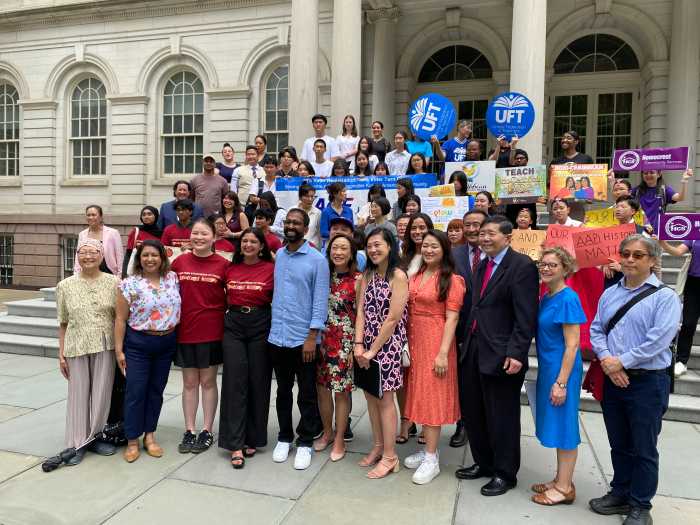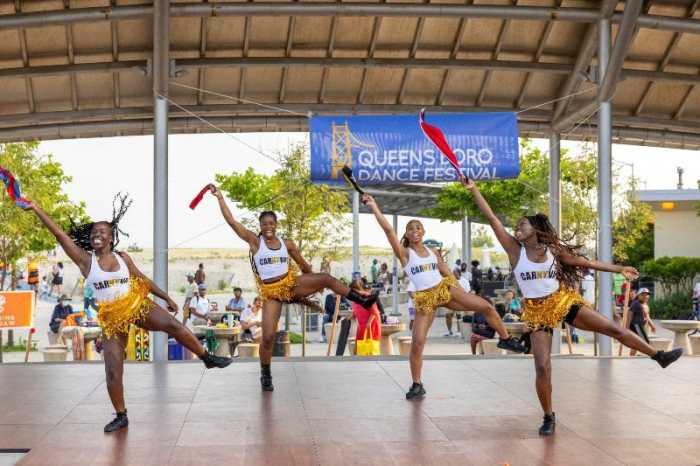Anyone who’s ever been strapped for cash — or desperate for a last-minute Halloween costume — has…
By Dustin Brown
Shopping at the Goodwill thrift stores in Astoria is like raiding your parents’ closet, only the selection is better and the clothes may actually fit.
Anyone who’s ever been strapped for cash — or desperate for a last-minute Halloween costume — has likely taken advantage of Goodwill’s eclectic stock and basement prices. It’s the place to go for fashion relics and fashion rejects, the store where clothes get a second chance on shoppers willing not to be the first.
For a substantial minority, however, the temporary treasures buried in the clothing racks are the least of what Goodwill has to offer.
Goodwill’s thrift shops are only the most public branch of a vast network of industries and services most people have no idea exist. While its stores on Ditmars and Steinway may be a great place to spend a buck, the Goodwill Industries site at 4-21 27th Avenue offers more than a few opportunities to earn one.
Its clients are immigrants, schoolchildren, the disabled, and basically “anybody who’s out of the employment mainstream,” said Rex Davidson, president and chief executive officer of Goodwill Industries of Greater New York.
Walking through the facility — which covers almost an entire city block — it’s impossible to tell employees from clients, for in many cases there is no distinction.
Clad in baggy blue jumpers and armed with bottles of disinfectant, the “Goodwill Clean Team” keeps the space so immaculate that the tangy scent of Lysol never quite drifts away. Like many jobs at the Goodwill site, spots on the Clean Team are divvied out to employment services clients, preparing them to eventually take janitorial jobs in the outside community.
Employment services have been woven into the fabric of Goodwill’s history ever since Edgar Helms founded the organization a century ago.
“He wanted to help people who were having a hard time — people with disabilities, people who were poor,” said Goodwill spokeswoman Martha Gotwals.
Helms tapped into a population that was desperate to be productive, and he gave them the chance by directing their energy back into his company.
“He started collecting clothing, then started to have the poor people sell the clothes for money and for a job,” Gotwals said.
The formula worked, and a hundred years later it remains the backbone of Goodwill’s success. The organization is powered by the very people it serves. The industries they staff, which include the thrift stores, a messenger service, and a temporary employment agency, bring in half of Goodwill’s funding, while the rest comes from Goodwill’s subcontracting of work to other organizations and grants.
While the benefits to Goodwill can be counted in dollars, for many clients the sense of fulfillment is far better compensation than the salaries.
“I was doing nothing for almost 20 years,” said Seymour Handel, who works for Goodwill’s messenger service. “No one wanted to hire me for so-called real jobs, but they took me in here and everything worked out OK. I’m standing on my own two feet — I’m standing on stilts now things are so good.”
The Astoria facility is in the Two Coves neighborhood, which juts into the East River on a small peninsula between Roosevelt and Randalls islands. Although Goodwill has offered programs here for about 25 years, the organization has made deeper inroads in the community by opening the Diane Armstrong Family Learning Center in 1997.
“We’re kind of a peninsula out here and we were forgotten,” Davidson said. “We were trying to inject hope back into the community.
The center is named for a woman who personifies the Goodwill philosophy of empowerment through employment She started as a secretary but rose to vice president by the time of her death. She strongly advocated for Goodwill to get more actively involved in the surrounding community.
“If you were here six years ago you would have seen 10 abandoned cars on the street, just hulks; the roads would be covered with potholes; the park would have been a drug den,” Davidson said. By meeting with local residents and addressing their concerns, he said, Goodwill has helped transform the drug den into a ballpark where 10 Little League teams relish the national past time every spring.
The Family Learning Center offers classes in computers, English as a Second Language, and GED preparation. Its clients range from recent immigrants to neighborhood mothers to developmentally disabled individuals looking to pick up a new skill.
The center is also heavily used by neighborhood young people after school until 6 p.m. Many of them are latch-key kids who otherwise would hang out on the streets unsupervised or sit alone at home.
“The power of work — that’s the key, for work provides dignity. It provides empowerment to people,” Davidson said. “Goodwill is still about giving people the opportunity to make their own work, to make their own paycheck and decide how they are going to spend it.”
Reach reporter Dustin Brown by e-mail at Timesledgr@aol.com or call 229-0300, Ext. 154.


































